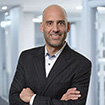Dear Reader:
Recently I visited the IMTS Show in Chicago’s McCormick Place, composed of its four very large exhibition halls. IMTS means International Machinery and Technolgy Show, North America’s largest machinery producer and supplier exhibition. Hosting exhibitors and visitors from 119 countries, IMTS 2012, which ran Sept. 10-15 at Chicago’s McCormick Place, covered 1.248 million net square feet of exhibit space with 1,909 exhibiting companies. Over 100,000 people attended the event. Very impressive indead. I remember this show from the early 2000’s when it had moved to the surburbs, Rosemont, IL, and it had trouble filling up a show area that was much smaller than McCormick Place. During my time at the show, a lot of people talked about “reshoring”, bringing production back to North America typically from Asia. The reasons for that seemed manifold but many of the concerns included increased supply chain costs, time for shipments, quality problems, communication difficulties based on language problems, concerns with Intellectual Property aspects, political uncertainties and many more.
Manufacturing in North America is experiencing a revival. Note this just 3 years ago, the Big Three automakers saw their factories running around 50 percent capacity. Now, it’s predicted they will be at greater than 100 percent capacity by year’s end. It’s uplifting news for the automotive industry, and manufacturing as a whole.
In a few days we are celebrating Manufacturing Day 2012 in the United States, another step to promote Manufacturing in our hemisphere: http://www.mfgday.com/event. It is a joyous occasion which will hopefully grow in popularity in the years to come. Check out a participating manufacturer near you and be impressed by modern manufacturing technology.
Still the problem we have in our country is that there is a lack of skilled workers. Since the 1970’s it has become the mantra that “only getting a college degree is the path to a successful career”. That is a failed plan. Less than 50% of freshman students graduate with a Bachelor degree, many of them incur large student debts which they have to pay back, degree or no degree. The latter of course excacerbates the individual situation. A failed college degree leaves the individual with a loss of time, a loss of money and little perspective where to go next in findng a decent paying job.
Learning a trade particularly in manufacturing is a great alternative. Yes, making things has a strong future. Creating value by making something will always be part of our society, part of what we do. Robots and automation have lowered costs and reduced mundane manual tasks in recent decades. That process will continue to increase productivity and lower operational costs. But skilled operators such as for CNC machining are currently in demand but will be in the years and decades ahead.
To compensate the shortfall that built up in prior decades there are many fledgling initiatives to address this problem. One example is the Center for Labor and Community Research in Chicago, IL (www.clcr.org). According to its Executive Director, Dan Swinney, the organization is working to rediscover, redefine and rebuild advanced manufacturing in the United States. Dan is pointng out that over 600,000 high-skill, high pay manufacturing jobs currently remain unfilled. There are pilot programs to alleviate this status. First CLCR initiated the Manufacturing Renaissance Council (MRC). MRC is a strategic, public/private partnership that operates regional programs in support of advanced manufacturing. According to the MRC advanced manufacturing is the development and production of high-tech, complex products. An economy based on advanced manufacturing holds the greatest potential to create sustainable, long-term economic growth; rebuild the American middle class; and solve the global environmental crisis. CLCR, as one example, is working with Austin Polytechnical Academy (www.austinpolytech.org) to interest young students in learning industry-recognized machining credentials from NIMS (National Institute for Metalworking Skills). http://www.austinpolytech.org/apa-senior-torres-hughes-featured-huffington-post. Illinois based Elgin Community College is hosting their first Manufacturer’s Symposium on October 25 www.elgindevelopment.com/workforcedevelopment. Furthermore according to the Daily Herald, the U.S. Department of Labor has awarded $12.9 million in federal funding to expand Harper College’s (HCC) new Advanced Manufacturing program to schools across Illinois (HCC, Palatine, IL) http://www.dailyherald.com/article/20120920/business/709209820/print/.
The Germany Embassy and its consulates around the country have initiated CEO roundtables and efforts to attract companies, especially German companies in the USA in this case, to help train a new generation of highly skilled workers. http://www.gaccsouth.com/en/news/single-view/artikel/ceo-roundtable-for-carolinas-discusses-skilled-workforce-development/?cHash=7db5b5d5b9638db9efba303c33d3ee0d. According to the Embassy website ‘through the “Skills Initiative,” the German Embassy is bringing together German and American businesses and local education/training providers with the aim of developing training programs best suited to businesses’ needs. The embassy launched “Skills Initiative” to identify and spread best practices in sustainable workforce development in the USA.
My company Plasmatreat North America (Elgin, IL, Ancaster, ON, Belmont, CA) is a strong advocate of “Made in the USA”. Our state-of-the-art equipment keeps production competitive, lowers costs, increases employee safety and is finally very positive for the environment as harmful and costly chemicals are replaced. For example Plasma Plus, a new innovation, just won the German Engineering price at the 2012 Hannover Fair, the largest industrial trade show in the world. http://www.plasmatreat.com/news/72_industry-award-2012_hanover-fair.html
Call me to discuss how we can help make American manufacturing great again.
Till next time,
Andy
Recommend









Write a comment